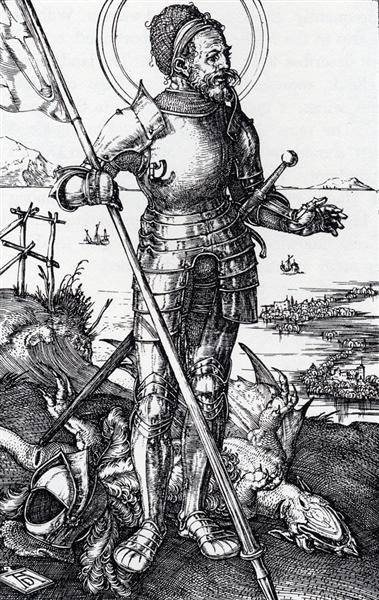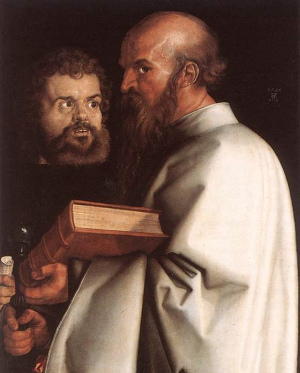Truth, goodness, and beauty are sometimes referred to as transcendentals, those things that come before and excel everything else. These things find their fullness in God who is the Truth, Goodness, and Beauty beyond all measure. Likewise, these things are reflected in creation, and in His creatures. This is also true in His people, the Church. This month we remember those who have gone before us who have, in the service of God, demonstrated these things including artists, parish pastors, and theologians. Through all these, our Lord has shown us His desire to save all people and has given us pictures of His grace in the lives of people.
All of these saints and days can be found in the Lutheran Service Book on pages xi-xiii. Those that are italicized are not found in LSB, but are in Liturgies et Cantiques Luthériens, the French language hymnal prepared by LCC and used by our French-speaking sister congregations as well as French Lutherans around the world. These can also be found on pages xi-xiii of the LCL.
All Scripture quotations are from the Evangelical Heritage Version.
April 6: Lucas Cranach and Albrecht Duerer, Artists

Lucas Cranach (c. 1472 – October 16, 1553) and Albrecht Duerer (May 2, 1471 – April 6, 1528) were two of the brightest lights in the Northern Renaissance. Both of these artists used their art to glorify God and depict the beauty of His creation. Lucas Cranach was the court painter of Frederick the Wise, Elector of Saxony. Because of this he had ready access to Luther and the other reformers and theologians in Wittenburg. Cranach supported the work of the Reformation and used his workshop to create paintings and woodcuts which proclaimed the Gospel and Scriptural teachings. He was also responsible for painting many of the portraits of those associated with the Reformation. Some of his other great works included many altar pieces which still adorn churches in Germany. Albrecht Duerer was court painter for Holy Roman Emperor Maximilian I. After the emperor died, he returned to his hometown of Nuremberg, where he continued to work. Duerer also had many religious themes in his artwork, including woodcut series on the Revelation to St. John as well as the Passion of our Lord. His own writings and those of his friends demonstrate that he too was a supporter of the Reformation. The council and mayor of his city, Nuremberg, was one of the original presenters of the Augsburg Confession in 1530. Both of these men in their vocation as artists glorified God through their skill as well as in much of the subject matter of their paintings. We give thanks to God for them and how God has shone through them as well as for all artists who continue to skillfully work today.
Ascribe to the Lord the glory of his name. Bring an offering and come before him. Worship the Lord in the splendor of holiness.
1 Chronicles 16:29
April 20: Johannes Bugenhagen, Pastor
_-_Johannes_Bugenhagen.jpg/1200px-Lucas_Cranach_(I)_-_Johannes_Bugenhagen.jpg)
Johannes Bugenhagen (June 24, 1485 – April 20, 1558), also known as Pomeranius, was a parish pastor in Wittenberg and responsible for organizing the reforming Church in Pomerania and Denmark-Norway. Bugenhagen was the parish pastor at St. Mary’s in Wittenberg during the Reformation and so often shared preaching and teaching duties with Martin Luther. One of the gifts which God had given Bugenhagen was that of organization and administration. This is demonstrated in his helping with Luther’s translation of the Bible, writing new Church Orders for a number of northern territories including Demnark-Norway, and eventually being appointed Superintendent of the Church in Saxony and overseeing all other pastors. In recognition of the importance of his work in Scandinavia, he is sometimes known as “the second apostle to the north” for his work in bringing the pure Gospel to the people whom Ansgar (the first “apostle to the north”) first brought the Gospel. In all of this, he was still also a pastor to the people in Wittenberg and continued to preach and administer the sacraments. Following Luther’s death Bugenhagen cared for his widow and children. We give thanks to God for the grace he has shown us in His servant Johannes Bugenhagen, and pray that He would continue to uphold all pastors in their vocations of serving His people.
He himself gave the apostles, as well as the prophets, as well as the evangelists, as well as the pastors and teachers, for the purpose of training the saints for the work of serving, in order to build up the body of Christ.
Ephesians 4:11-12
April 21: Anselm of Canterbury, Theologian

Anselm of Canterbury (c. 1033 – April 21, 1109) was an Archbishop of Canterbury and author of a very important and influential work on the incarnation and atonement. Anselm grew up in what is now Italy and after a time of carefree living eventually ended up in a monastery in Bec, France. Due to his relationship with Lafranc, the last Archbishop of Canterbury, the English bishops earnestly desired to have Anselm take his place. While originally reluctant, he accepted the position. As archbishop, Anselm took up the job of reforming the Church in England, including dealing with the investiture controversy. As a result, he ran into conflict with the secular authorities and was exiled on more than one occasion. In the midst of all this Anselm wrote many theological and philosophical writings. Because of this he is known as the Father of Scholasticism. One of his most important works, Cur Deus Homo (Why the God-Man? or Why did God Become Man?), explores purpose of the incarnation according to the Scriptures and what happened in the atonement. In it, he beautifully writes and explains Christ making satisfaction for sins by means of being a substitute for humanity in His death. We give thanks to God for Anselm, who taught the truth and clearly pointed to Christ as our substitute who vicariously died for us.
For God was pleased to have all his fullness dwell in [Jesus], and through him to reconcile all things to himself (whether things on earth or in heaven) by making peace through the blood of his cross.
Colossians 1:19-20
April 23: George, Martyr

George (d. April 23, 303) was a soldier in the Roman military, and martyr in the Roman Emperor Diocletian’s persecution of Christians within the army. Not too much is known of George’s life. He was born to a father of Greek background and mother from Palestine in the province of Cappadocia in modern day Turkey. After his father’s death, George and his mother returned to Palestine. It was there where he joined the Roman army. As a soldier, George did not hide his faith in Christ, but openly followed the Lord. As a result, he would not pray to the specific pagan gods associated with his legion nor to the emperor. When Diocletian ordered the persecution of Christians George refused to give up the faith and so was executed. The Holy Spirit, working through George’s proclamation of Christ in his death, brought some of the witnesses of his martyrdom to faith in Christ. Around 700 years later, the account of his life grew so great that it was said he saved an entire village from a dragon. While this much later addition is legendary, we know George was a faithful witness for Christ and even today gives us encouragement to remain faithful to Christ even in the face of death.
But you, O man of God, flee from these things and pursue righteousness, godliness, faith, love, perseverance, and gentleness. Fight the good fight of faith. Take hold of eternal life, to which you were called and about which you made your good confession in the presence of many witnesses.
1 Timothy 6:11-12
April 24: Johann Walter, Kantor

Johann Walter (1496 – March 25, 1570) was a composer of sacred music during the time of the Reformation. Walter was the chief cantor in the court of Duke Frederick the Wise of Saxony. Walter wrote the music for many of the early evangelical hymns, putting the Gospel message and teaching of true doctrine into the mouths of clergy and laypeople alike in the form of song. Because he was in Wittenberg, Walter often worked with Luther to write tunes and setting the for choir. Some examples are the credal hymn “We All Believe in One True God,” the Easter hymn “Christ Jesus Lay in Death’s Strong Bands,” and other hymns such as “A Mighty Fortress is Our God” (click here for a choral setting of “A Mighty Fortress”). Walter also was the editor of the first hymnal made for choirs during the Reformation, allowing the truth of God to be spread by song and to accompany the Word of God with beauty. He also wrote hymn texts as well, and in our hymnal we can find this in LSB 514, “The Bridegroom Soon Will Call Us.” Following the death of Frederick the Wise Walter accepted a call to be the cantor of the choir in Torgau where he continued to praise and glorify God through his music while also teaching the faith and building up the Church. We give thanks to God for Johann Walter and all other church musicians and all musicians who glorify God with their talents.
Shout for joy, you heavens, because of what the Lord is doing. Make a joyful shout, you depths of the earth. Burst forth with shouts of joy, you mountains, you forest and every tree in it, because the Lord has redeemed Jacob, and in Israel he will display his beauty.
Isaiah 44:23
April 25: St. Mark, Evangelist

St. Mark (5 – April 25, 68) the evangelist is one of the four writers of the Gospels which we have in the Holy Scriptures giving us an account of the Lord Jesus Christ’s life, death, and resurrection. Mark’s Gospel gives us the name for the four books because it begins “The beginning of the Gospel of Jesus Christ, the Son of God” (Mark 1:1). Mark is often identified with John Mark, the cousin of Barnabas, who is mentioned throughout the book of Acts as a companion of St. Paul and Barnabas (Acts 12:25, 13:5, 13:13-14, 15:37-40). Marks’ Gospel is often characterized as fast moving. It begins with the ministry of John the Baptist and the baptism of Jesus and continues with events happening one after another after another. Many times these events in Jesus’ life are connected with the adverb, “immediately.” Because of a number of thoughts of Peter in the Gospel (such as Mark 9:5-6 “Peter said to Jesus, ‘Rabbi, it is good for us to be here. Let us make three tents: one for you, one for Moses, and one for Elijah.’ He did not know what to say because they were terrified.”) it is traditionally said that Peter was the source for Mark’s Gospel, for he himself was not an eyewitness to these things. Traditionally Mark is said to have later went to Egypt after he completed his Gospel, where he founded the Church in Alexandria. In art, each of the four evangelists are identified with one of the four living creatures in Revelation. Mark is identified with the winged lion because of the forcefulness of which he presents Jesus’ preaching and teaching. In the three year lectionary the second year is dedicated to focusing primarily on Mark’s Gospel, as we are this year. We give thanks to God for His apostles and evangelists through whom He brought the word of salvation to so many in their day and continues to do so through their words in His Church.
The beginning of the gospel of Jesus Christ, the Son of God.
Mark 1:1